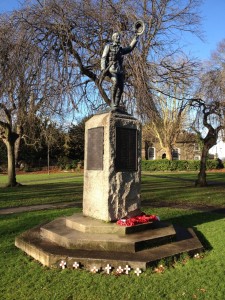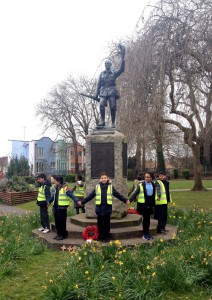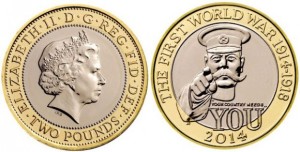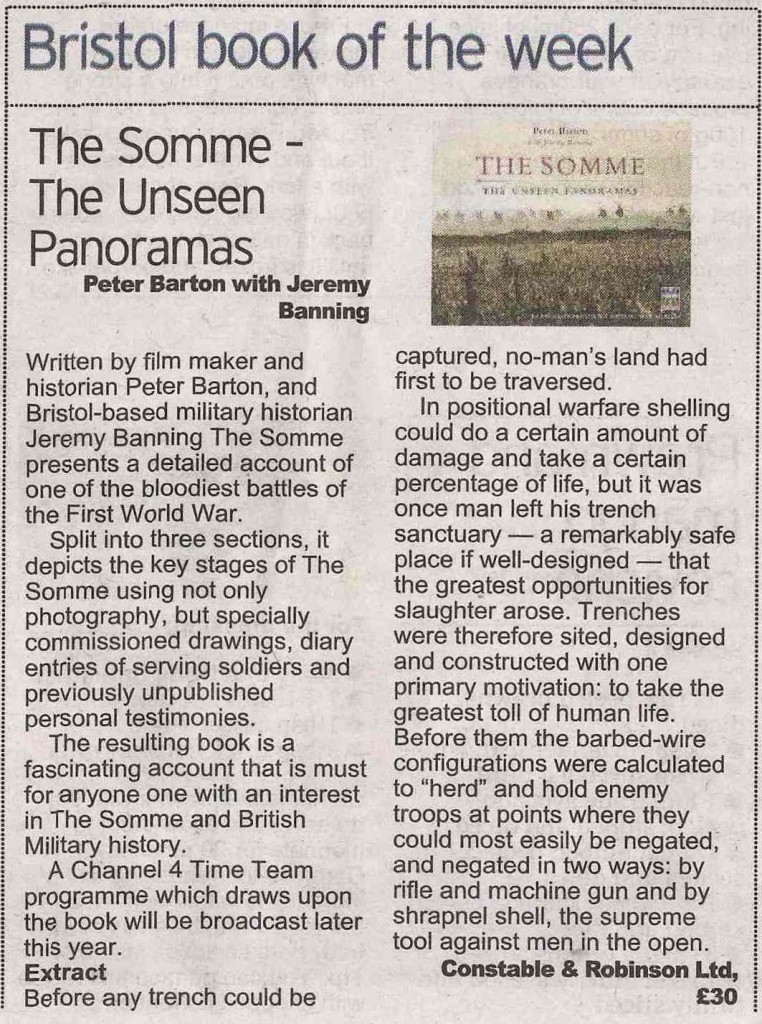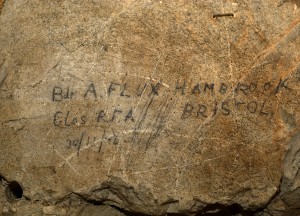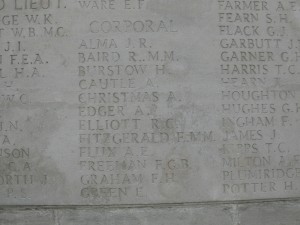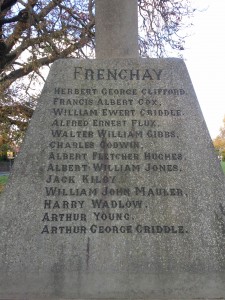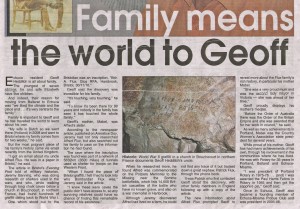Posts Tagged ‘Bristol’
New Battlefield Tour announced! ‘Western Front Footsteps’ 28 September – 1 October 2018
Following the success of 2016’s ‘Bristol on the Western Front’ and last year’s ‘The West Country at War’ tour trip that I organised with fellow historian, Clive Burlton, we are pleased to announce another trip for this coming autumn.
Stops will cover actions by units from Wiltshire, Somerset and South Wales as well as Bristol. The tour is named ‘Western Front Footsteps’.
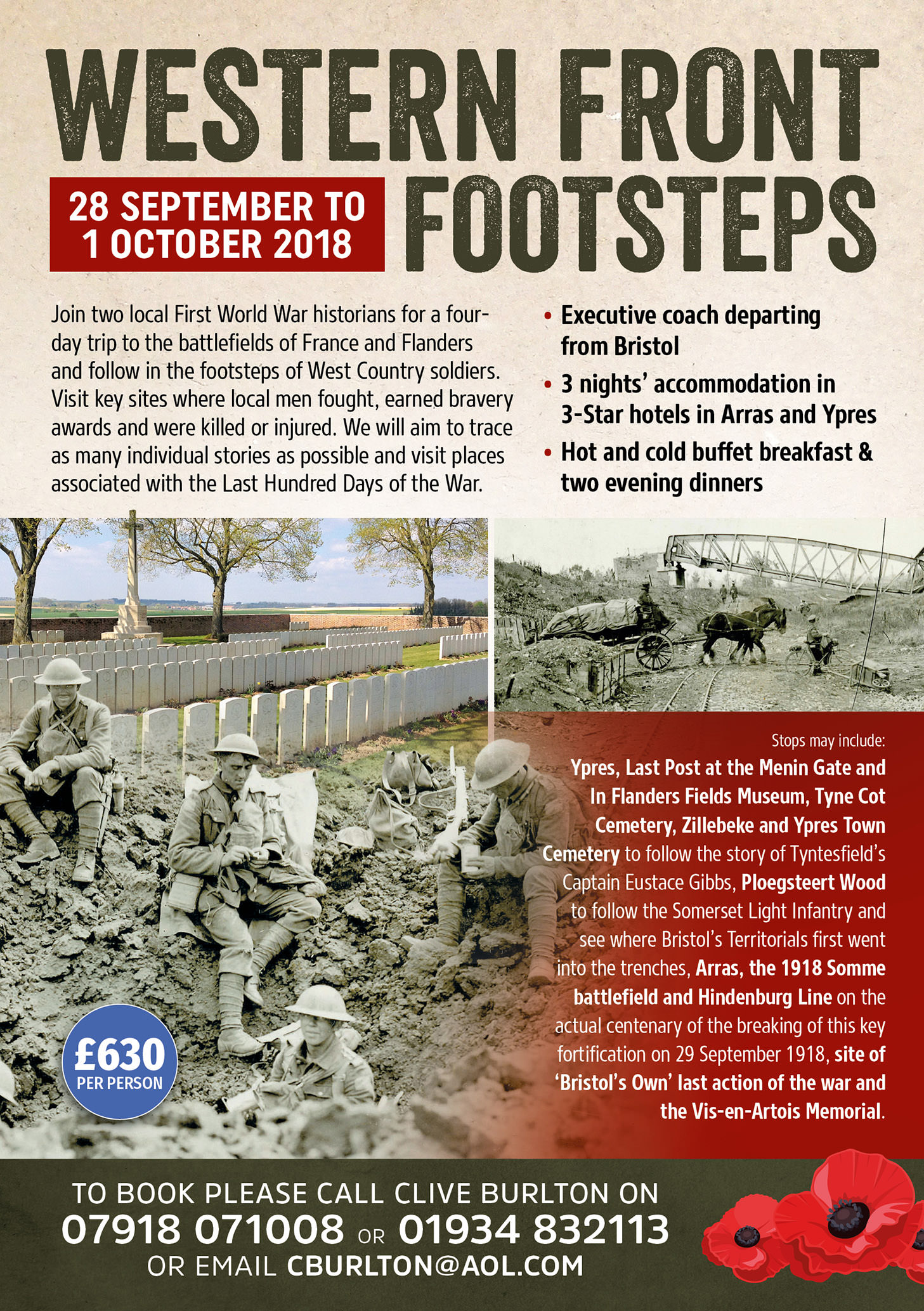
Once again we are travelling with our partners at Bakers Dolphin. The three night, four day tour will visit key sites where soldiers from the West Country fought, earned bravery awards and lost their lives.
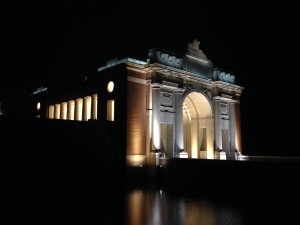
Menin Gate, Ypres
Travelling by executive coach we will depart from Bristol on 28 September and travel to Arras, stopping at sites of interest en route. The next day will be spent on the 1918 Somme battlefield on the centenary of the breaking of the Hindenburg Line – a momentous day that paved the way to allied victory. It is also the centenary of the last assault ever made by the 12th Gloucesters (Bristol’s Own) and we will walk their final attack. It will be special to visit this fascinating battlefield on such a poignant day.
On 30 September we will journey northward to the sacred Ypres salient , the wartime cauldron for so many of Britain’s soldiers. Whilst in Ypres we will attend the Last Post ceremony at the Menin Gate and visit the In Flanders Fields Museum in the Cloth Hall. Our time in Ypres will see us visiting sites around the salient including Ploegsteert (known as Plugstreet to the Tommies) to follow the 1st Somerset Light Infantry in December 1914, see where the Christmas Truce took place and visit the area in which Bristol’s Territorials first went into the trenches.

A key theme of this year’s tour will be looking into the wartime history of the Gibbs family from Tyntesfield (now a National Trust property) – their story is fascinating and heart-rending.

Ypres Cloth Hall – now the location for the In Flanders Fields Museum
Accommodation is based at the following 3-star hotels – Holiday Inn Express (Arras) and the Novotel (Ypres). Full details of cost, what is included and contact details to reserve a space can be found on the attached flyer.
We look forward to you joining us for another wonderful few days following in some Western Front Footsteps!
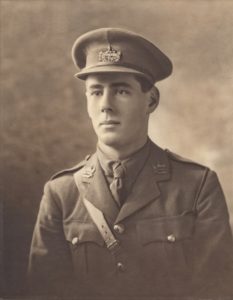
Second Lieutenant Hardy Falconer Parsons VC, 14th Gloucestershire Regiment. Image courtesy Soldiers of Gloucestershire Museum, Ref GLRRM:04750.6
Today saw the unveiling of a Bristol Civic Society blue plaque at the former Bristol home of my local Victoria Cross recipient, 2/Lt Hardy Falconer Parsons VC, 14th Gloucestershire Regiment. He lived a fifteen minute walk from my house and I have known his story for the past fourteen years that I have lived in the city.
My colleague Clive Burlton and I were determined to see Hardy’s strong association with Bristol and the West Country recognised. As his Government funded VC commemorative stone was unveiled in Rishton, Lancashire back in August we have spent the last year working on honouring Hardy’s local connections with a Bristol Civic Society blue plaque.
The plaque was unveiled by the Archie Smith and Grace Tyrrell, Head Boy and Head Girl of Kingswood School along with the Lord Mayor of Bristol, Cllr Lesley Alexander. The ceremony was attended by members of the Bristol Civic Society; the former Gloucestershire Regiment; the Soldiers of Gloucestershire Museum; the Bristol University Officer Training Corps; Kingswood School, Bath, Redland Green School and Dolphin Schools in Bristol; bandsmen from the Salamanca Band of the Rifles Regiment; members of the Western Front Association and the Bristol Great War network and representatives of the Kingswood Association, whose generous donation enabled the plaque to be made and installed. Also attending were the Deputy Lord-Lieutenant for the County and City of Bristol, Colonel Andrew Flint and the Dean of Bristol, the Very Rev Dr David Hoyle. In total, around 100 people were in attendance for the ceremony. Afterwards a sizeable number of us were invited back to the Artillery Grounds on Whiteladies Road for light refreshments as guests of Bristol University Officer Training Corps.
Images of the unveiling ceremony can found below, followed by the culmination of much detailed research into Hardy’s life by Clive Burlton and myself. I can only hope that the people of Bristol and Bath embrace his memory. He deserves that.
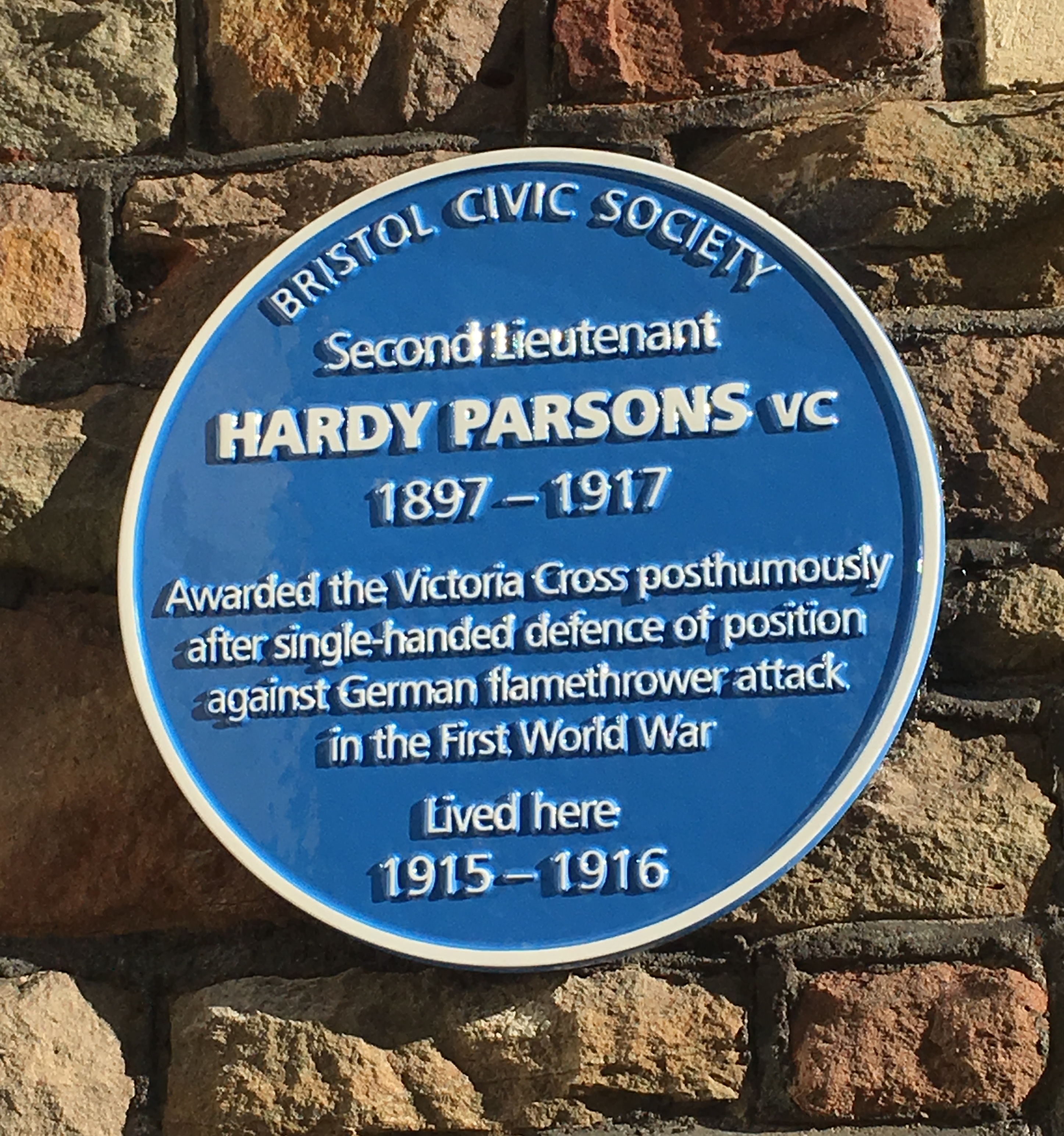
Blue plaque for Hardy Falconer Parsons VC at 54, Salisbury Road, Redland, Bristol
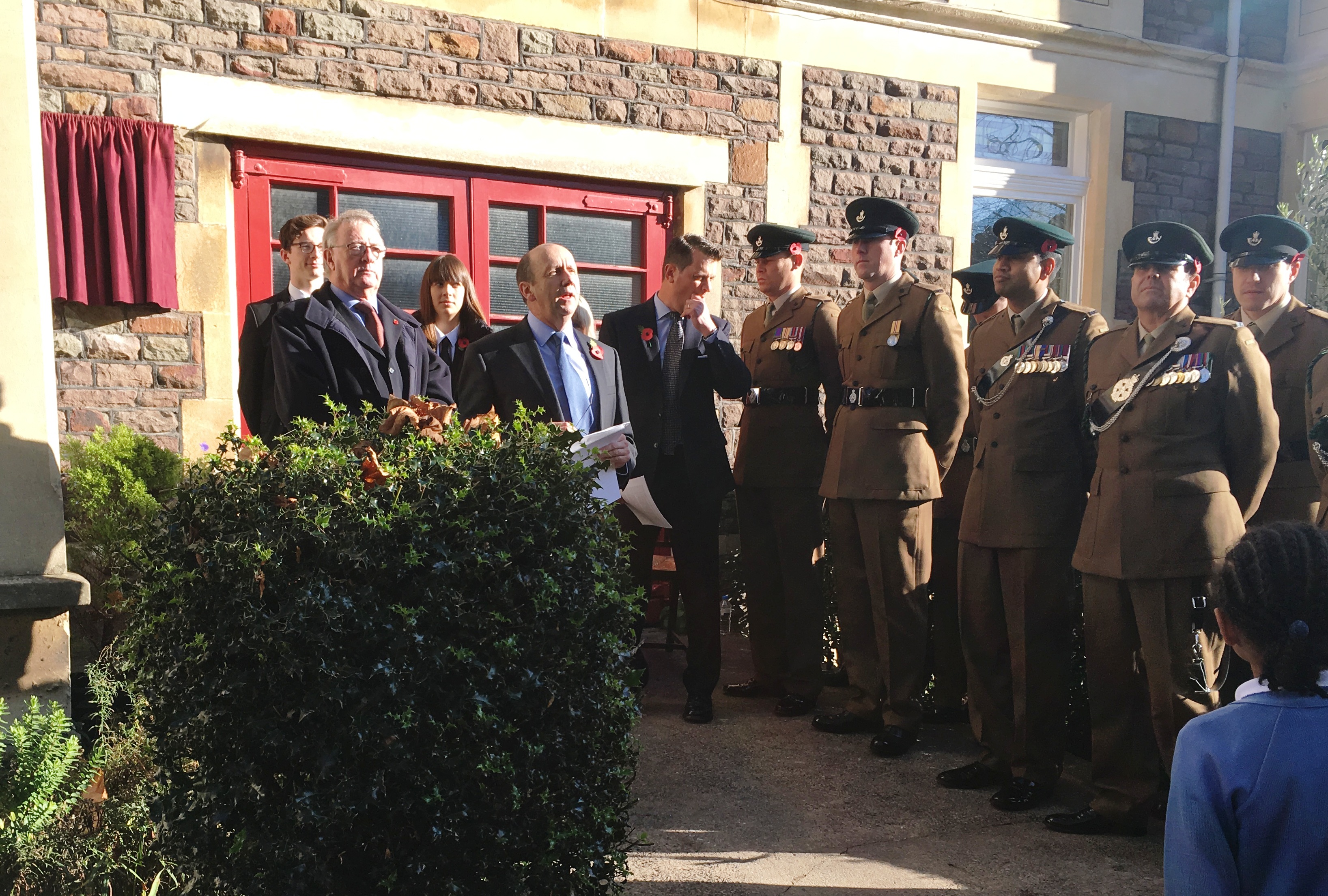
Clive Burlton gives the opening address
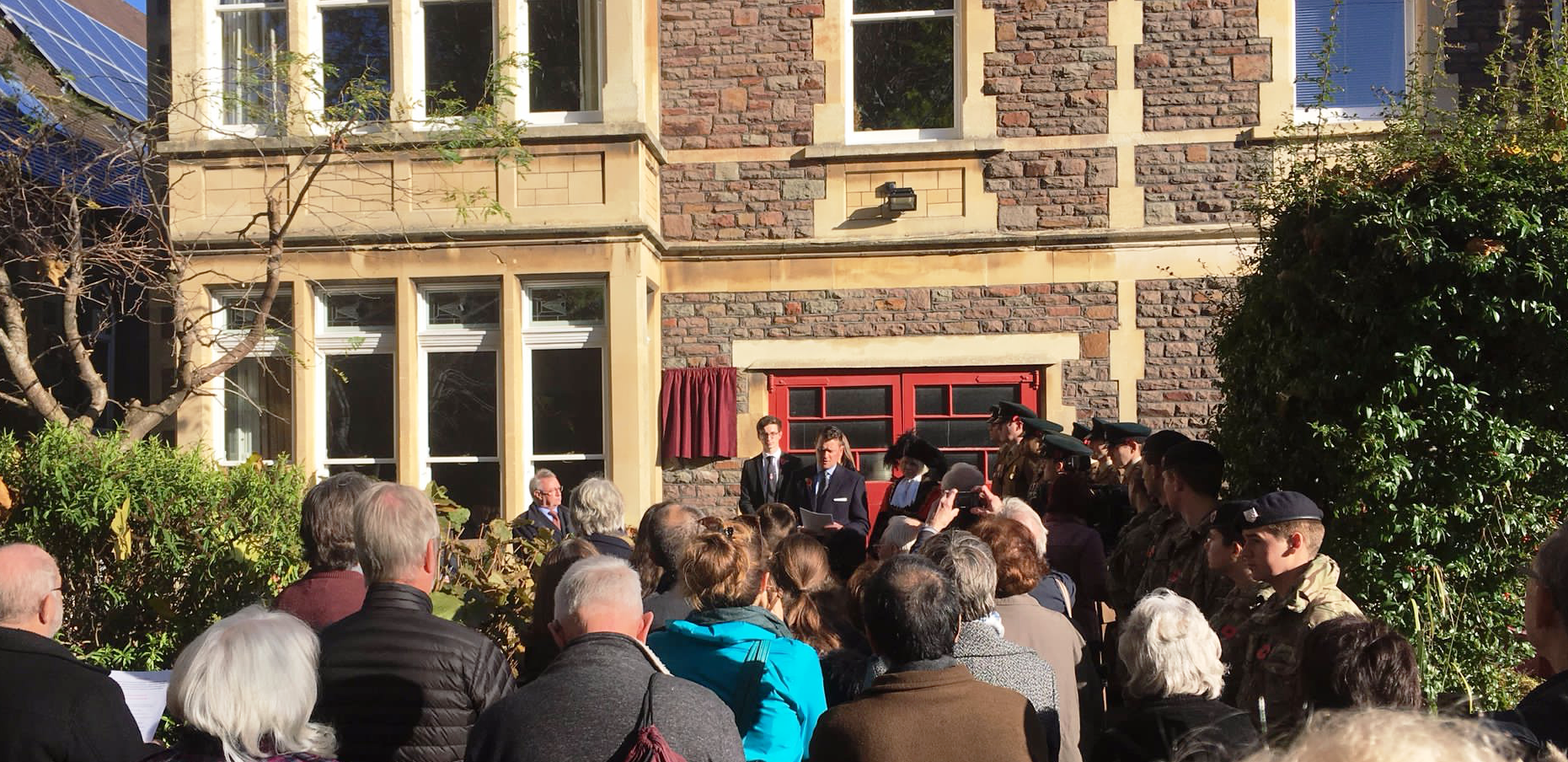
Jeremy Banning providing the historical background to the life of Hardy Falconer Parsons VC
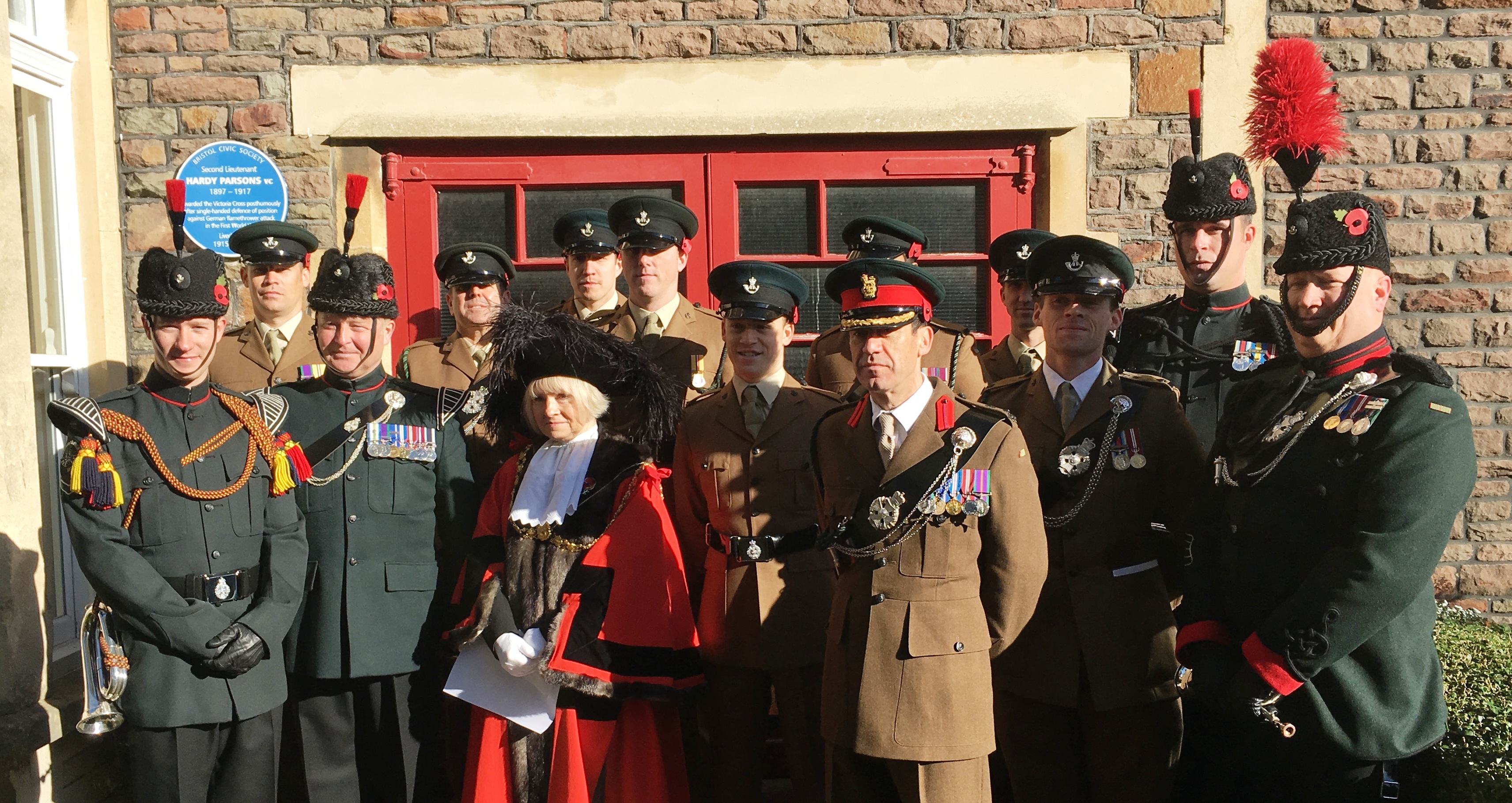
The Lord Mayor of Bristol with members of Bristol University Officer Training Corps and bandsmen from the Salamanca Band of the Rifles
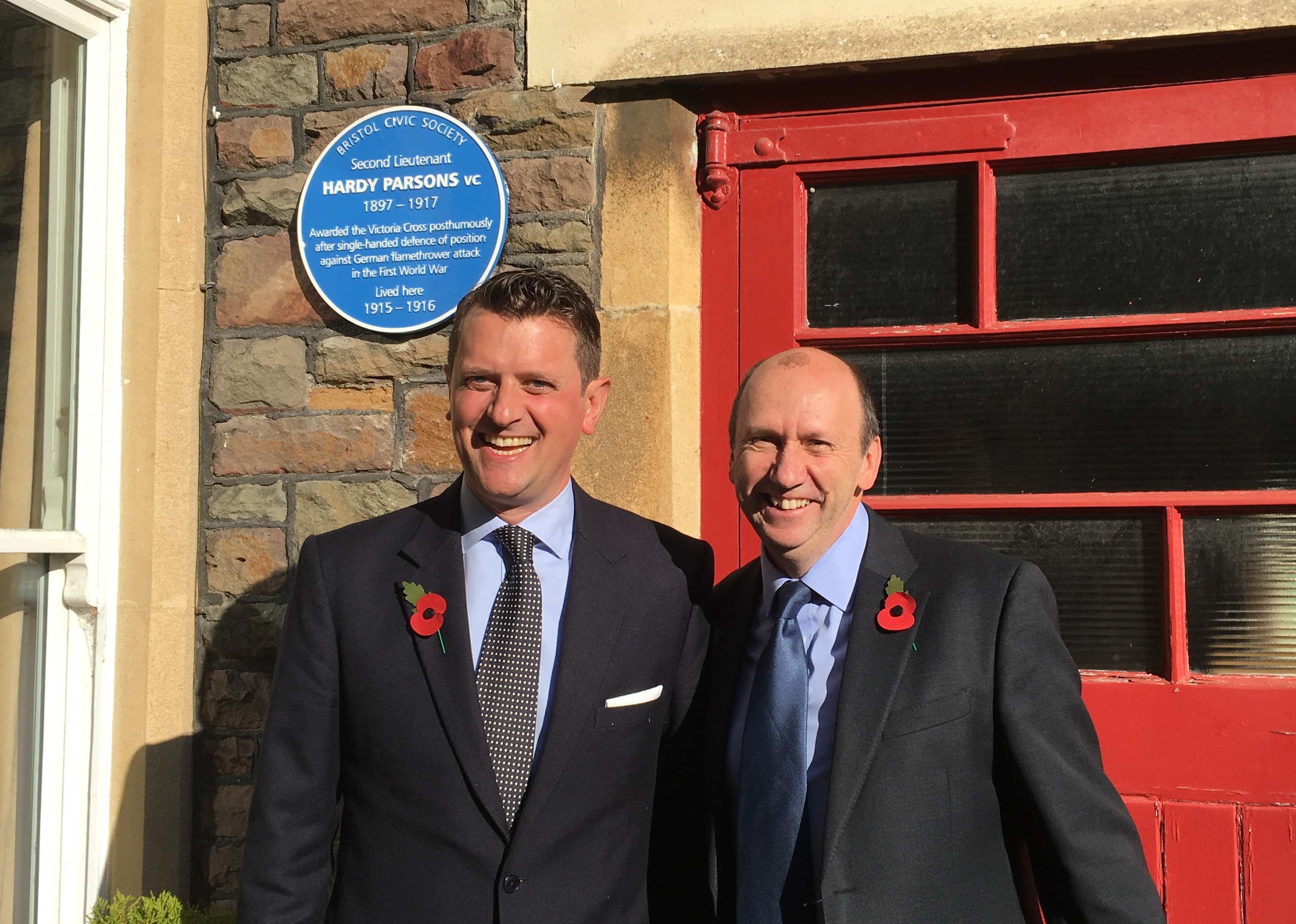
A delighted Jeremy Banning and Clive Burlton with Hardy’s new blue plaque
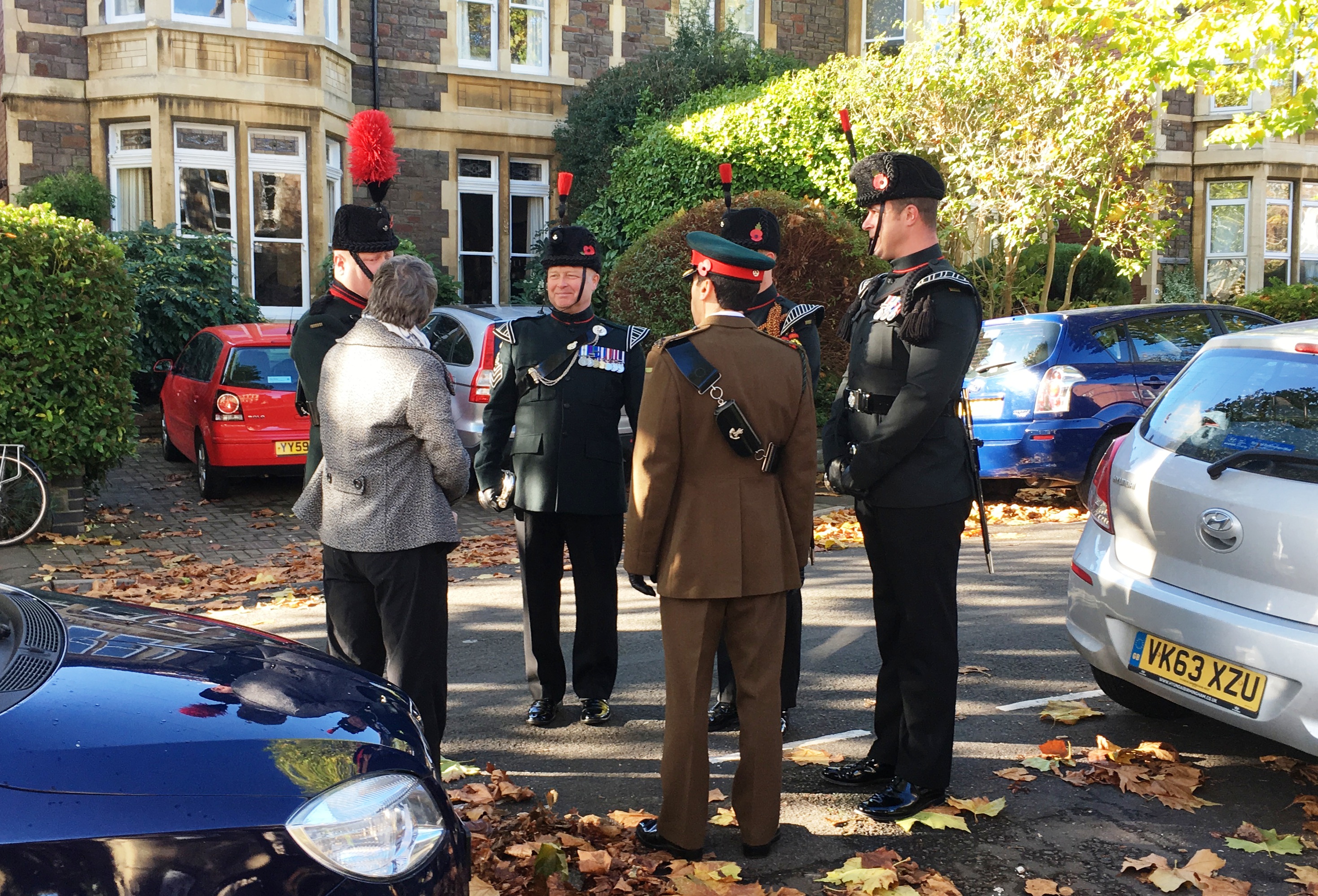
The ceremony was well attended by the military
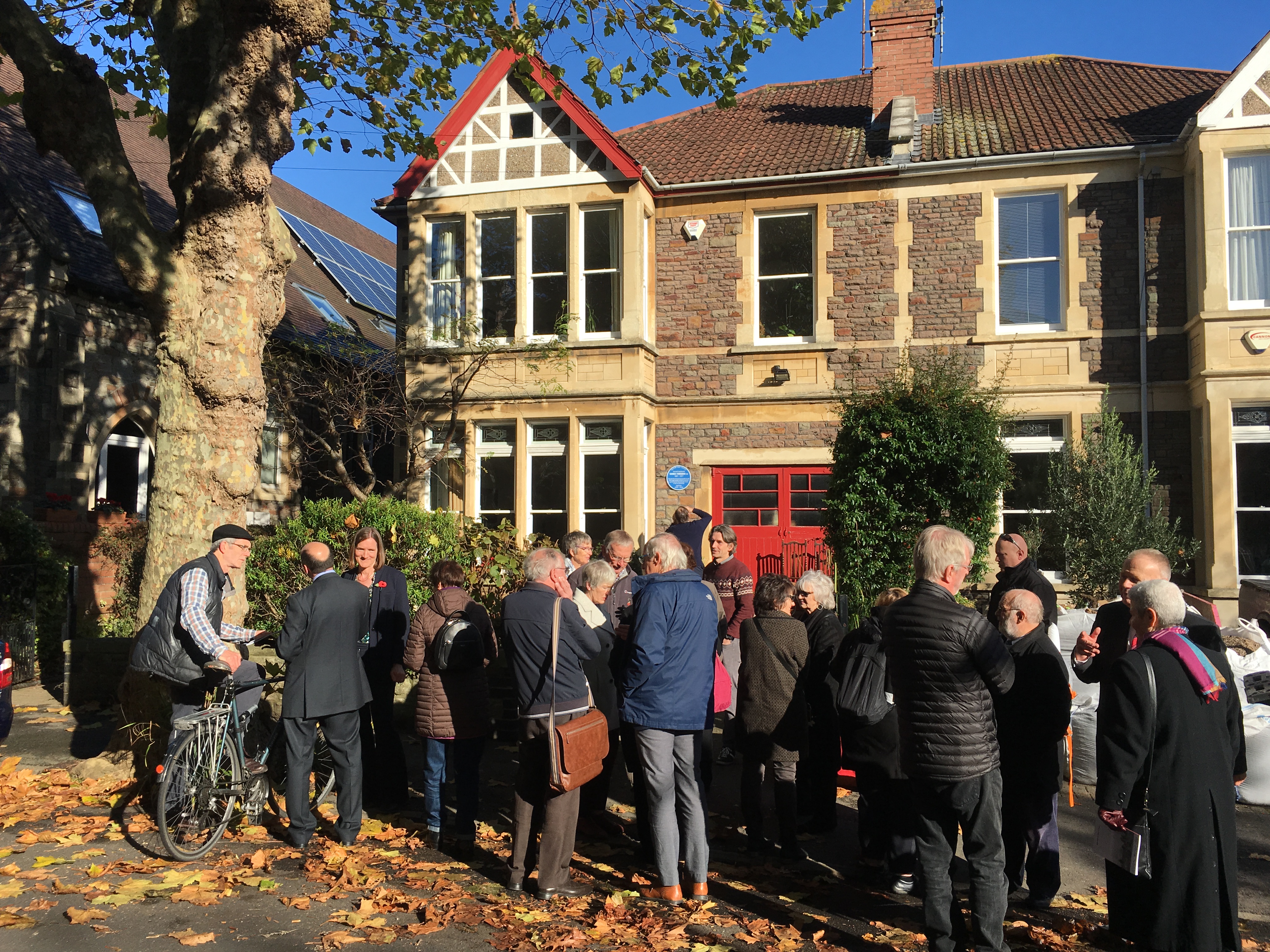
After the ceremony many of those attended were able to mingle and discuss Hardy’s life
Bristol 24/7 have also covered the story: https://www.bristol247.com/news-and-features/news/pictures-blue-plaque-revealed-wwi-soldier-redland/ as have BBC News: http://www.bbc.co.uk/news/uk-england-bristol-41918314. Our BBC Points West interview is available for a week from 16 minutes in here: https://www.bbc.co.uk/iplayer/episode/b09bzw5f/points-west-evening-news-08112017
The life of Hardy Falconer Parsons VC, 14th Battalion, Gloucestershire Regiment
Hardy Falconer Parsons was born on 30 June 1897 at Rishton, near Blackburn, Lancashire, the first of three boys. His father, the Rev James Ash Parsons, was a Wesleyan Minister whilst his mother Henrietta (known as Rita) was the daughter of a railway inspector from York. Hardy’s rather unusual middle name came from Rita – Falconer was her maiden name.
The Rev James Ash Parsons had spent eleven years in total in the slums of East London as superintendent of the Methodist Leysian Mission. Ill health forced him and Rita to St Anne’s on Sea, south of Blackpool and it was whilst living here that Hardy was born. There followed three years at Arnside immediately south of the Lake District. Clearly, the ethos of duty and service to others, so well practiced by his parents, was a huge part of Hardy’s upbringing.
Hardy’s first school was King Edward VII School at Lytham St Annes. From the paper work we have found it appears the family moved to Bristol in 1912 when the Rev James Ash Parsons became pastor at the Old King Street Wesleyan Chapel (sadly, now demolished). The family moved to 54 Salisbury Road in Redland and Hardy attended Kingswood School in Bath until April 1915.
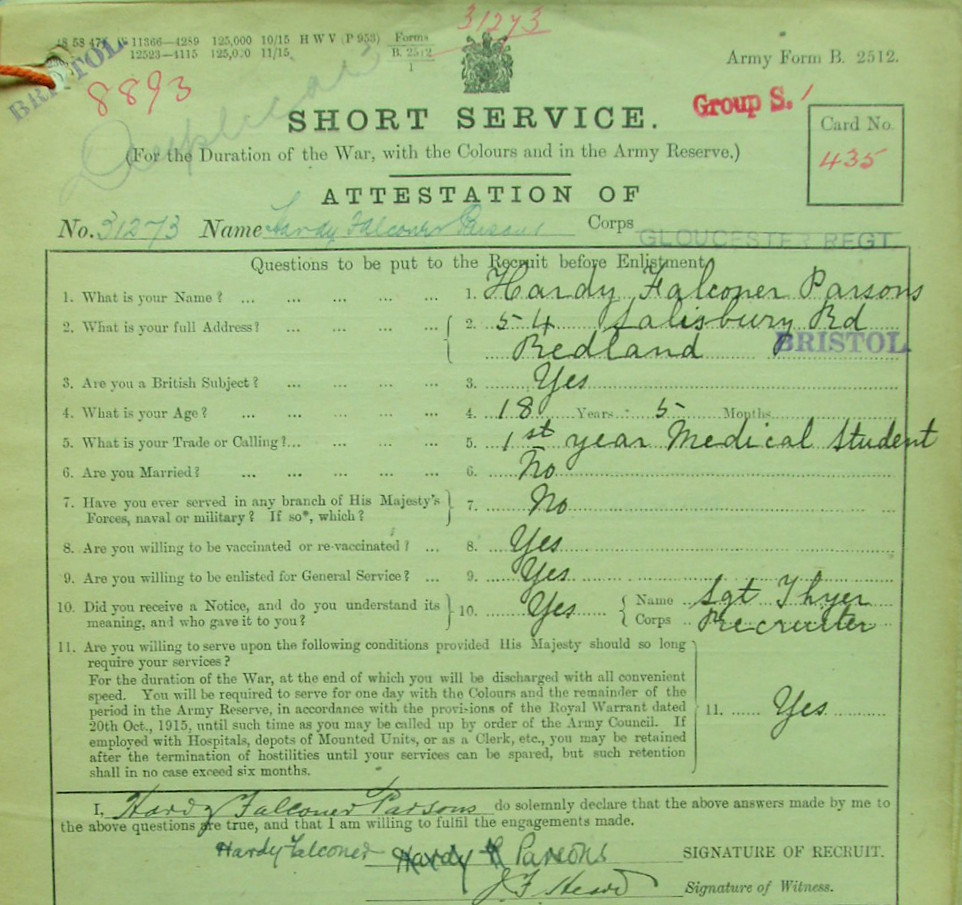
Extract from attestation papers of Hardy Falconer Parsons (National Archives: WO339/73298)
After school Hardy Parsons became a Medical Student at Bristol University with the aim of becoming a medical missionary. At the end of November 1915, during his first year at the University he signalled his wish to volunteer for service by attesting when aged just 18 years & 5 months but was immediately placed on the Army Reserve.
He had previously declined a safe post in a Government munitions laboratory, feeling that he ought not to withhold himself from the fullest sacrifice. He hated war, but recognised that the making of munitions was just as much war work as was the actual taking of life.
He joined the University’s Officer Training Corps in May 1916, a month shy of his 19th birthday, and then passed his first Bachelor of Medicine degree. His attestation papers make interesting reading – recording that he was a tall man, especially for that time, standing at 6ft ¾ inch tall. In early October 1916 he was posted to 6th Officer Cadet Battalion at Balliol College, Oxford and, on 25 January 1917, was appointed to the Gloucestershire Regiment as a Second Lieutenant.
He eventually joined the 14th Battalion in March, a unit which had previously been a ‘Bantam’ battalion – with men of 5ft 3 inches and less serving in its ranks. By the time the nearly 6ft 1 inch Hardy joined the battalion this unique distinction had been very much diluted. In February 1917 the battalion war diary records 475 ‘normal size men’ joining the battalion.
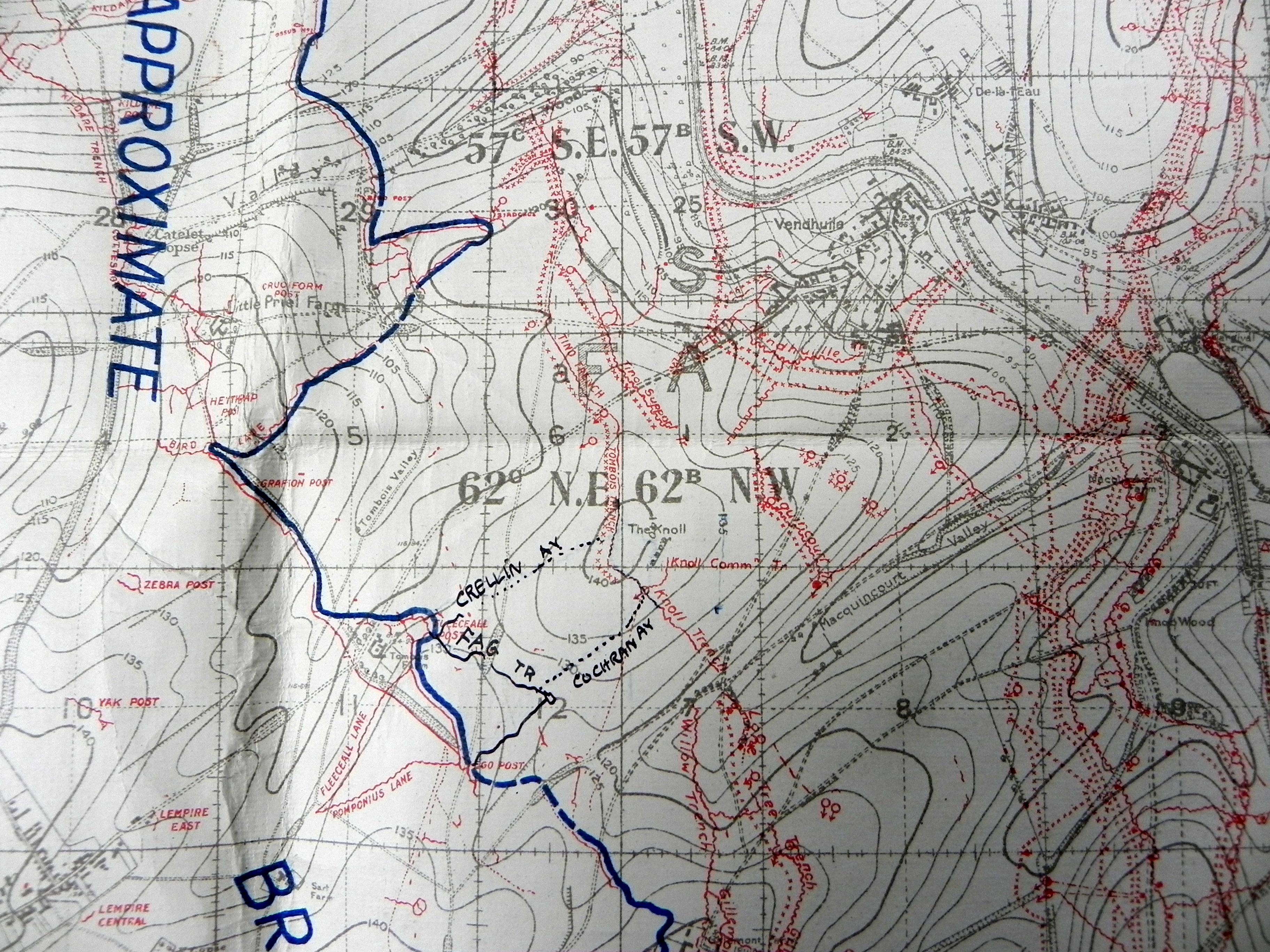
Trench map extract of The Knoll – captured by 105 Infantry Brigade on 19 August 1917
On 21 August 1917 near the village of Vendhuile in the eastern part of the Somme, Hardy’s battalion were holding recently captured trenches at a position known as The Knoll in the Hindenburg Line outpost zone. Their relief of the units who had captured the Knoll some two days before was completed by 1.30am that night.
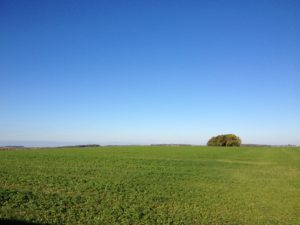
Modern view of The Knoll, photographed October 2017. Vendhuile, the Hindenburg Line and St Quentin Canal are out of view in the valley.
It was a critical position which afforded observation over the Hindenburg Line and St Quentin canal a mile away – observation the British wanted and the Germans wanted to prevent. In fact, men from Bristol’s 1/4th and 1/6th Territorial battalions had fought for the same view in this same position four months previously.
The loss of such critical terrain forced the Germans into a devastating counter-attack. As recorded in the Brigade war diary, at 3.51am the Germans struck. Militarily, it was a brilliantly executed counter-attack by the Germans – The Knoll being attacked at four points simultaneously. German infantry were accompanied by special detachments using portable flamethrowers. These forced Hardy Parsons’ men back. However, he alone stuck to his bombing post and held his position, throwing bombs (hand grenades) at approaching Germans until a British counter-attack could be launched. The counter-attack was successful – the Germans were repulsed from the trenches around The Knoll and within 40 minutes this bloody action was over. Much of this success is due to Hardy’s refusal to yield ground.
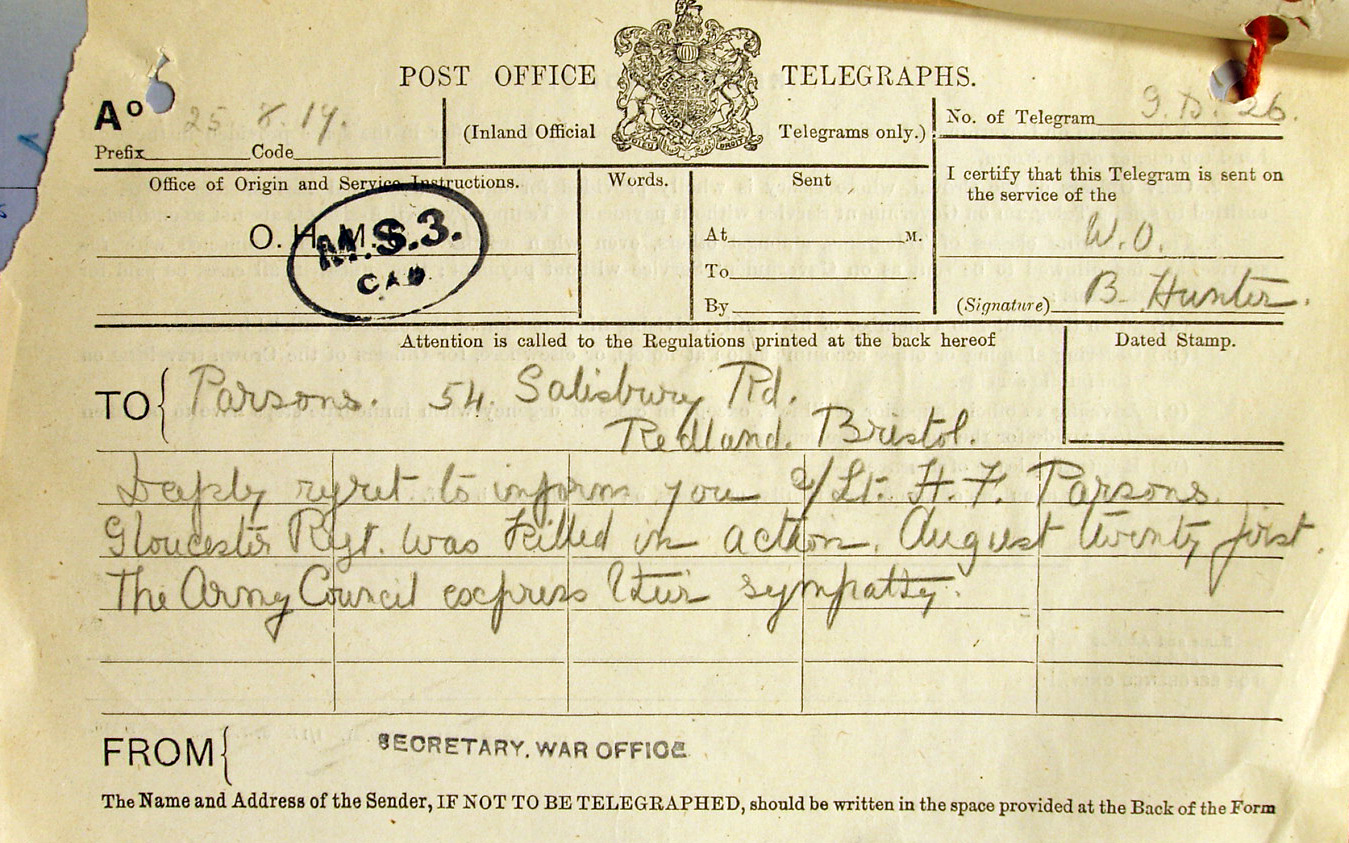
Telegram sent to the Rev James Ash Parsons informing him of Hardy’s death
During his heroic sole defence of The Knoll Hardy had been severely burnt by liquid fire. Writing these words over a hundred years later I cannot begin to imagine the sense of duty that compelled him to stay at his post, or the pain he would have endured during and after sustaining such horrific burns. Unsurprisingly, the nature of his wounds proved too severe and he succumbed later that day, dying at the age of just 20 years and two months. Hardy Falconer Parsons is buried in the immaculate CWGC cemetery at Villers-Faucon.
N.B. I was contacted in August 2019 by Dr Markus Schroeder whose great great uncle, Ernst Komander, served with the 2./Jäger 6, Jäger-Regiment 6, 195 Infanterie-Division. He tells me that regimental records show it was Jäger-Regiment 6 that led the attack on the 14th Gloucesters with the specialist flamethrowers employed by Sturmbataillon 3. Ernst Komander was wounded on the day of the attack and died of those wounds two days later. He is buried in Block 2, Grave 56 in Caudry German Military Cemetery.
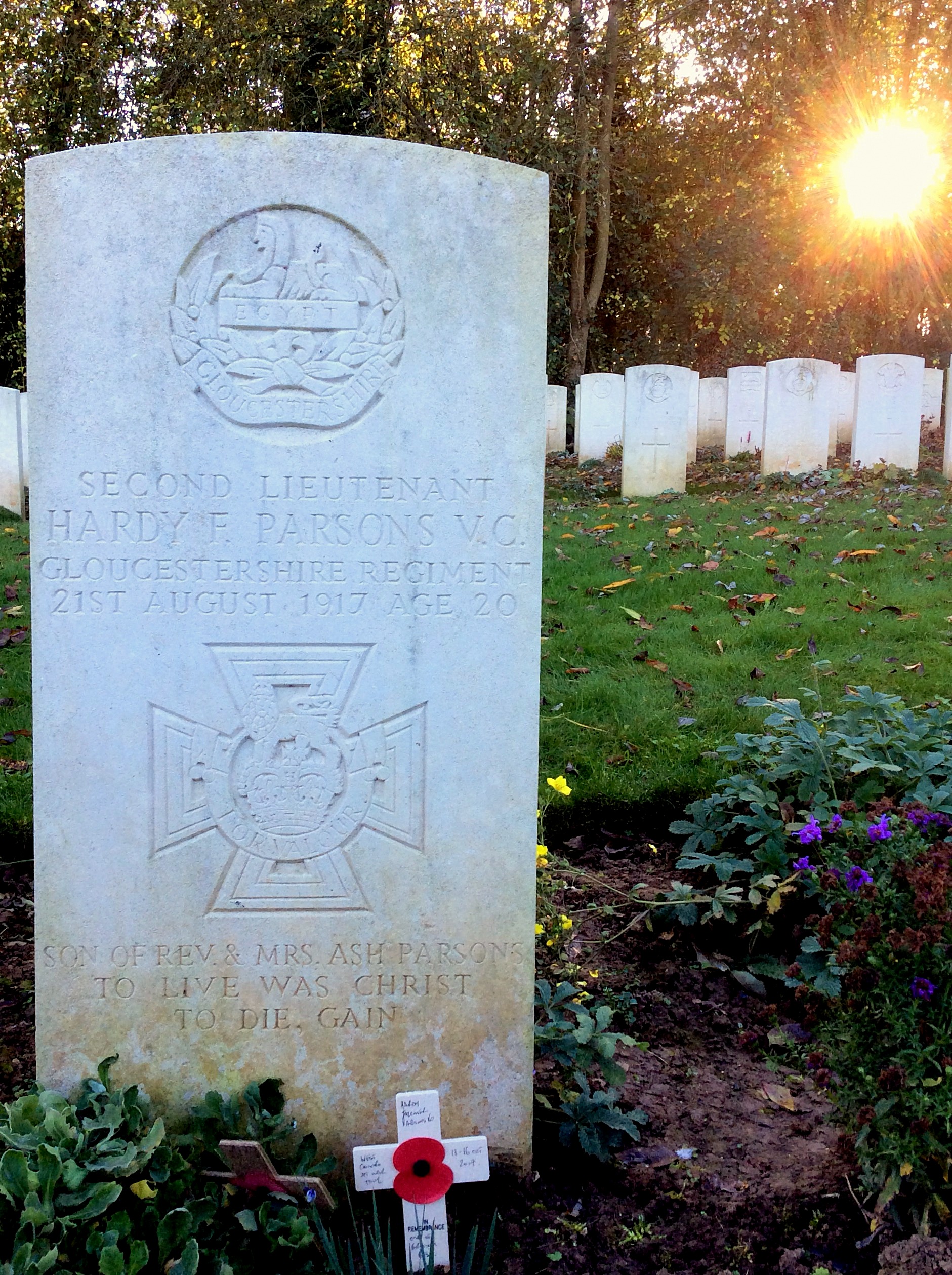
Grave of Hardy Falconer Parsons VC at Villers Faucon Communal Cemetery
Hardy’s effects, consisting of just a wrist ID disc and two wrist watches were sent by registered post to his father within the month.

105 Infantry Brigade war diary describing the events of 21 August 1917
The Brigade diary describes Hardy’s gallantry, commenting that he ‘was afterwards recommended for the VC for his action’. During the war many acts of bravery were put forward for the VC but subsequently rejected. However, in Hardy’s case, approval was given. He was posthumously awarded the Victoria Cross – personally presented to his father by King George V at a ceremony on Durdham Down (Bristol) on 8 November 1917. Hardy’s father also attended the Colston Hall event on 15 February 1919 when he was presented, on his dead son’s behalf, with an illuminated address and gold watch by Lord Mayor Twiggs. The address included Hardy’s full Victoria Cross citation:
“For most conspicuous bravery during a night attack by a strong party of the enemy on a bombing post held by his command. The bombers holding the block were forced back, but Second Lieutenant Parsons remained at his post, and, single-handed, and although severely scorched and burnt by liquid fire, he continued to hold up the enemy with bombs until severely wounded. This very gallant act of self-sacrifice and devotion to duty undoubtedly delayed the enemy long enough to allow the organisation of a bombing party, which succeeded in driving back the enemy before they could enter any portion of the trenches. This gallant officer succumbed to his wounds.”
Hardy Parsons was only the second member of the Gloucestershire Regiment to receive a VC during the First World War.

Hardy Falconer Parsons VC Chapel Memorial, Kingswood School, Bath
On 23 July 1923, a tablet in his memory was unveiled in the chapel of Kingswood School in Bath and his Victoria Cross and campaign medals are held by the Soldiers of Gloucestershire Museum, having been presented to the Gloucestershire Regiment at a ceremony in 1970 in front of what is now City Hall, attended by the Lord Mayor, Cllr Bert Wilcox.
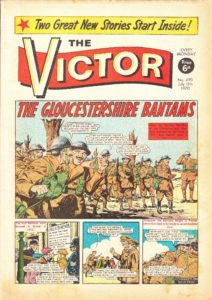
Victor comic, 11 July 1970 – the story of Hardy Falconer Parsons VC
The collection also includes a portrait photograph of Hardy in uniform; the bronze memorial plaque sent, popularly known as the “Dead Man’s Penny” to his parents after the war and his Gloucestershire Regiment collar badge. Engraved on the back of the badge are the words “Irene Randall 10 Newfoundland St., Bristol 1917”. Who she was, and why he had that, we will probably never know….
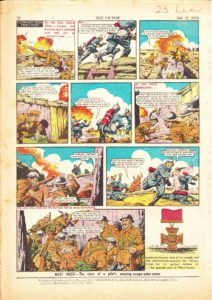
Victor comic, 11 July 1970 – the story of Hardy Falconer Parsons VC
On 11 July 1970, the Victor Comic ran a cartoon story with 10 sketches on its front and back pages, recounting the story of the 14th Gloucesters action at The Knoll and to the deeds of Hardy Falconer Parsons – bringing his heroic actions to the attention of a younger audience.
Ewart Moulton Parsons
And as for the Parsons family, despite Hardy’s death, the war had not finished with them. Hardy had two younger brothers; Ewart Moulton and Lyall Ash. Lyall was born too late to serve but Ewart, born the year after Hardy, was working as an apprentice engineer at Bristol company, Brecknell Munro and Rogers in summer 1916.
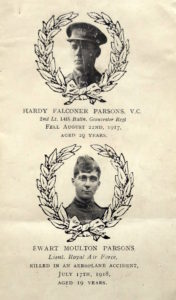
Page from memorial booklet for Hardy and Ewart Parsons
He joined the Royal Flying Corps in 1917 and by 17 July 1918, was a 19 year old Lieutenant and pilot in No.50 Training Depot Station at Eastbourne, flying his Sopwith F1 Camel fighter high above the Seaplane Station. What happened next is still unclear but his plane went into a spin and plummeted to the ground from 3000ft. Unsurprisingly, Ewart was killed instantly.
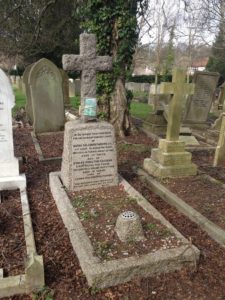
Grave of Ewart Parsons in Canford Cemetery, Bristol
His body was brought back to Bristol and his funeral held at the Old King Street Wesleyan Chapel where his father was the pastor. The coffin was borne by six RAF officers and taken on a gun carriage to Canford Cemetery, where the internment took place followed by the sounding of the Last Post.
So, in the space of eleven months James Ash and Rita Parsons had lost two of their three boys. On the base of the stone cross marking Ewart’s grave at Canford Cemetery the family also commemorated his brother, Hardy. Like so many families across the world, the Parsons’ suffered grievously in the war.
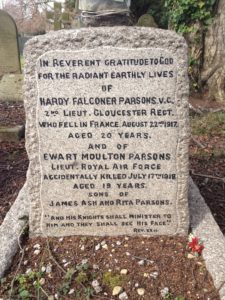
Detail on Ewart Parsons’ grave in Canford Cemetery
But, as this research is primarily based on Hardy I would like to end with a description of him, provided by his father which, when considered alongside his Victoria Cross action, shows him to have been a truly remarkable young man, a perfect example of the loss of the best of that generation:
“Hardy lived all of his life from early childhood on the same high plane of self-forgetfulness and sacrifice in his thought for and service of others”
Hardy Falconer Parsons VC (30 June 1897 – 21 August 1917)
Sources of information consulted for this article include:
Service record of Hardy Falconer Parsons VC (National Archives: WO339/73298)
105 Infantry Brigade War Diary (National Archives: WO95/2486)
14 Battalion Gloucestershire Regiment War Diary (National Archives: WO95/2486)
RAF service record of Ewart Moulton Parsons
Census returns (1901 & 1911)
Material from the Soldiers of Gloucestershire Museum http://www.soldiersofglos.com/
Victor Comic, 11 July 1970
London Gazette – various dates
The Kingswood Magazine, Vol. XX, No.10, December 1917
North Devon Journal, 27 August 1931
North Devon Journal, 10 November 1949
Gliddon, Gerald, VCs of the First World War: Cambrai 1917, Stroud, 2004

Second Lieutenant Hardy Falconer Parsons VC, 14th Gloucestershire Regiment. Image courtesy Soldiers of Gloucestershire Museum, Ref GLRRM:04750.6
On 8 November 2017 a Bristol Civic Society Blue Plaque for Hardy Falconer Parsons VC, 14th Gloucestershire Regiment (my local Victoria Cross recipient) will be unveiled at 54 Salisbury Road, Redland, Bristol. The date is 100 years to the day after King George V personally presented Hardy’s VC to his father, Rev James Ash Parsons at a ceremony on Durdham Downs.
Between 2014 and 2019 the Government is funding the production and placing of a commemorative stone for each and every Victoria Cross recipient of the First World War. Although Hardy Falconer Parsons lived at 54 Salisbury Road, he was not born in Bristol. So in August the government-funded commemorative stone relating to Hardy Parsons, was laid in Rishton, Lancashire.
Local historian and author Clive Burlton and I were determined to see Hardy’s strong association with Bristol and the West Country recognised. If we couldn’t have the government-funded stone in Bristol, the next best thing was to have a Bristol Blue plaque unveiled in his honour.
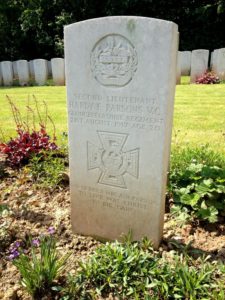
The grave of Hardy Falconer Parsons VC at Villers-Faucon Communal Cemetery
So, during the past year we have organised for the creation of the plaque. Wednesday’s ceremony, starting at 11am, will have representatives from the Bristol Civic Society; the former Gloucestershire Regiment; the Soldiers of Gloucestershire Museum; the Bristol University Officer Training Corps; Kingswood School, Bath, Redland Green School and Dolphin Schools in Bristol; bandsmen from the Salamanca Band of the Rifles Regiment; the Western Front Association; members of the Bristol Great War network and representatives of the Kingswood Association, whose generous donation enabled the plaque to be made and installed. Also attending are the Lord Mayor of Bristol, Cllr Lesley Alexander; the Deputy Lord-Lieutenant for the County and City of Bristol, Colonel Andrew Flint and the Dean of Bristol, the Very Rev Dr David Hoyle.
The event is open to the public so please do come along and attend if you can. I will be posting the results of my research on Hardy Parsons along with photos of Wednesday’s ceremony on my website later this week. In the meantime, it is worth reading Hardy’s VC citation to have an idea of his valour:
“For most conspicuous bravery during a night attack by a strong party of the enemy on a bombing post held by his command. The bombers holding the block were forced back, but Second Lieutenant Parsons remained at his post, and, single-handed, and although severely scorched and burnt by liquid fire, he continued to hold up the enemy with bombs until severely wounded. This very gallant act of self-sacrifice and devotion to duty undoubtedly delayed the enemy long enough to allow the organisation of a bombing party, which succeeded in driving back the enemy before they could enter any portion of the trenches. This gallant officer succumbed to his wounds.”
There should be a short film on Hardy’s action on Wednesday evening’s Points West (BBC1) from 6.30pm.
Following the success of last year’s ‘Bristol on the Western Front’ trip that I organised with fellow historian, Clive Burlton, we are pleased to announce another trip for October 2017.
This year we are broadening the net with less of a Bristolian focus. Stops will cover actions by units from Wiltshire, Somerset and South Wales. As such, we thought it apt to name the tour ‘The West Country at War’.
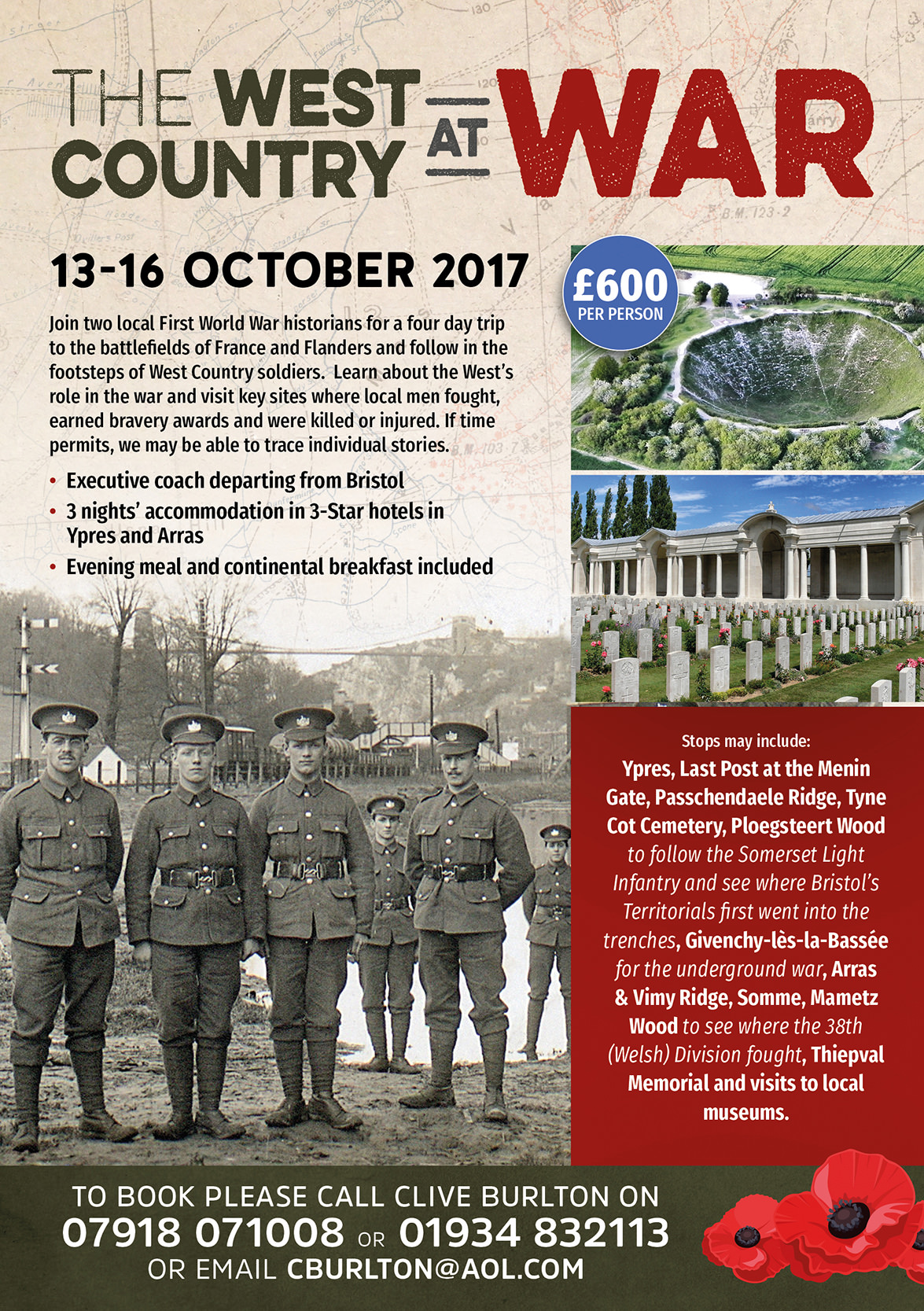
Once again we are travelling with our partners at Bakers Dolphin. The three night, four day tour will visit key sites where soldiers from the West Country fought, earned bravery awards and lost their lives.

Menin Gate, Ypres
Travelling by executive coach we will depart from Bristol on 13 October and travel to Arras, stopping at sites of interest en route. The next day will be spent on the Somme battlefields, visiting some well known (Mametz Wood) as well as lesser known sites on the 1917 battlefield!
The following day sees us journey northward to the sacred Ypres salient , the wartime cauldron for so many of Britain’s soldiers. Whilst in Ypres we will attend the Last Post ceremony at the Menin Gate. Our time in Ypres will see us visiting sites around the salient including Ploegsteert (known as Plugstreet to the Tommies) to follow the 1st Somerset Light Infantry in December 1914, see where the Christmas Truce took place and visit the area in which Bristol’s Territorials first went into the trenches.
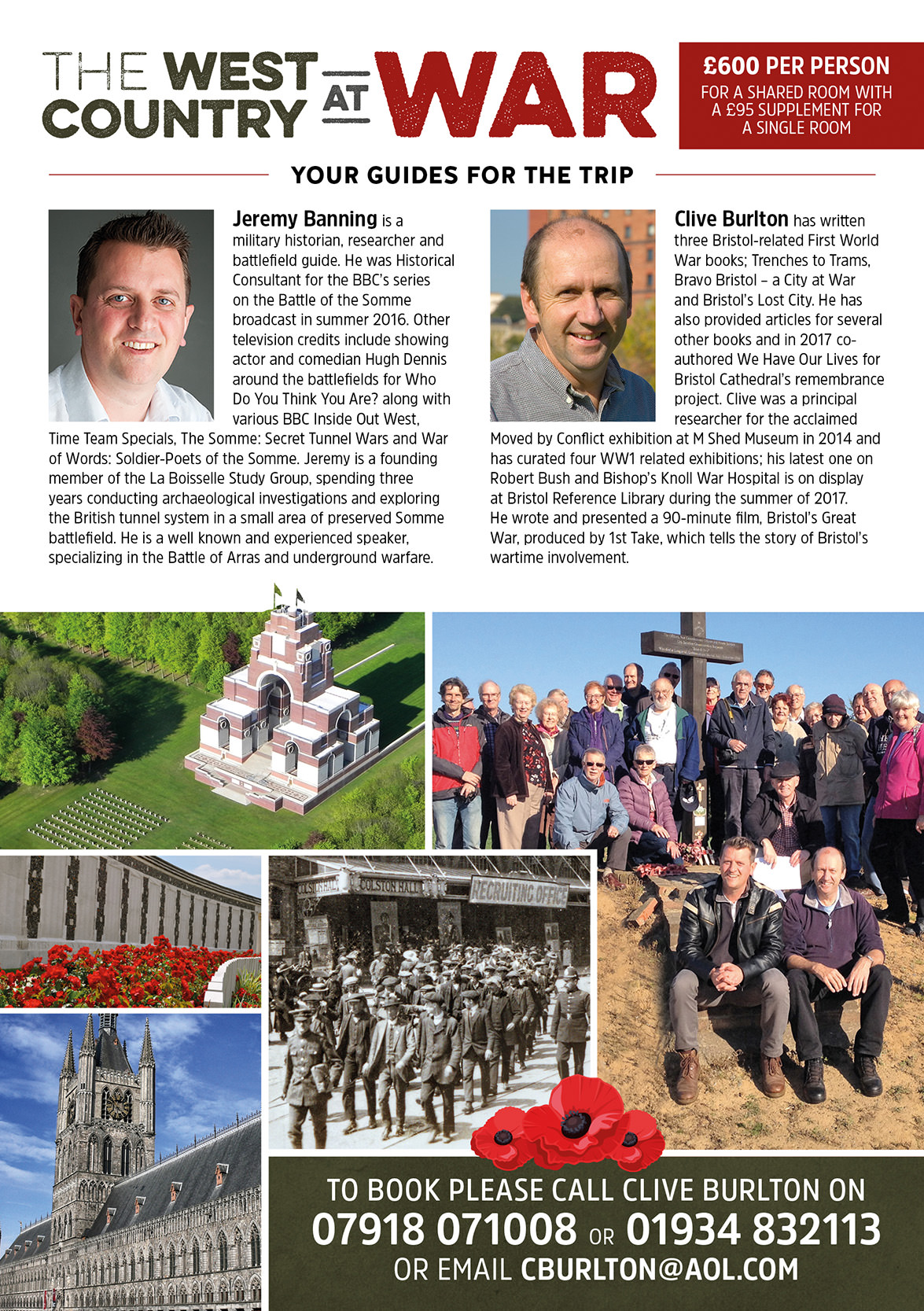
Accommodation is based at the following 3-star hotels – Holiday Inn Express (Arras) and the Novotel (Ypres). Evening meal and continental breakfast are included. If there is demand then Clive and I are happy to give evening talks. Last year we were heartened by the almost 100% attendance rate at our talks by those who had already had a long day on the battlefields.
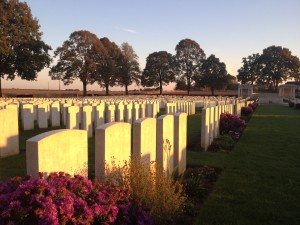
Delville Wood Cemetery, Somme
Full details of cost and contact details to reserve a space can be found on the attached flyer.
We look forward to you joining us for another wonderful few days!
Through my work for Historic England I have come to know many stories of Bristol’s soldiers in the war. A few years ago I met Clive Burlton, a local historian and writer with a superb knowledge of Bristol’s role in the war. Clive and I have given talks at the same venue on a number of occasions and over a post-talk beer often discussed the possibility of running a coach tour to the battlefields for people who want to find out more about Bristol’s wartime story.
So, here we are! I am pleased to announce that, with our partners at Bakers Dolphin, we are running a special tour:
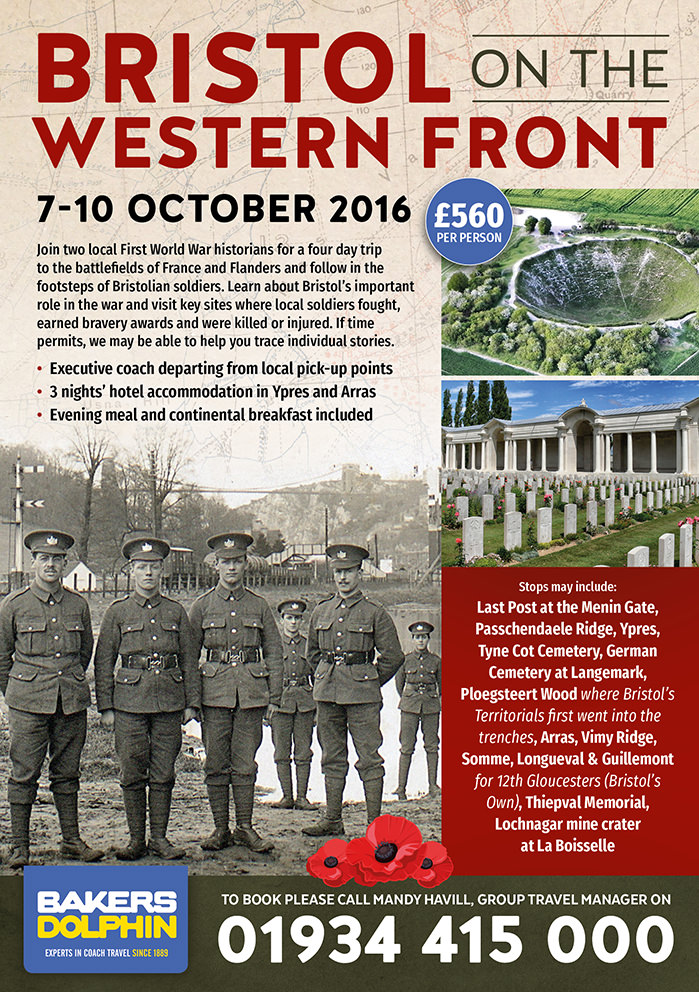
The three night, four day tour will visit key sites where soldiers from Bristol fought, earned bravery awards and lost their lives.
Travelling by executive coach we will depart from Bristol on 7 October and travel to the sacred Ypres salient, the wartime cauldron for so many of Britain’s soldiers. That evening we will attend the Last Post ceremony at the Menin Gate that night. The next day sees us visiting sites around the salient including Ploegsteert (known as Plugstreet to the Tommies) to see where Bristol’s Territorials first went into the trenches before heading south to Arras, our base for the remainder of the trip.
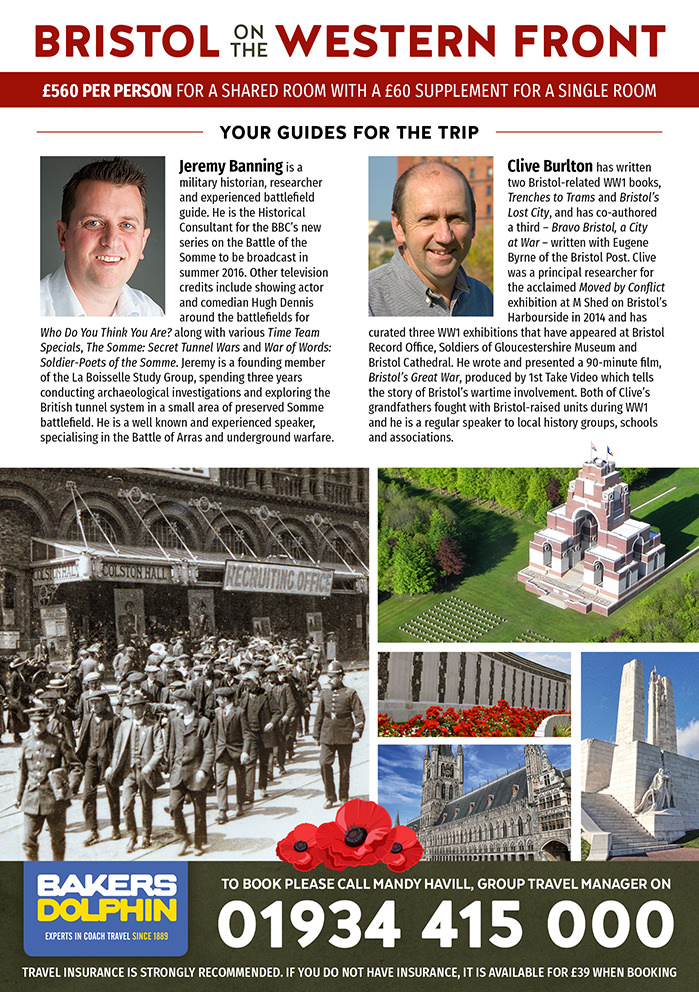
On Saturday 9th we will spend a day on the Somme battlefields, visiting key sites such as Newfoundland Memorial Park, Thiepval Memorial and the Lochnagar Mine Crater. We will also look at the story of the 12th Gloucesters (Bristol’s Own) in their actions at Longueval and Guillemont. The morning of our final day will be spent on the Arras battlefield, looking at the events surrounding the 12th Gloucesters (Bristol’s Own) action at Fresnoy on 8-9 May 1917.
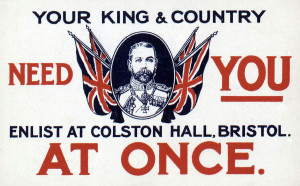
Wartime recruiting card for local soldiers to enlist at Colston Hall, Bristol
Accommodation is based at the following 3-star hotels – Novotel (Ypres) and Holiday Inn Express (Arras). Evening meal and continental breakfast are included. If there is demand then I will give a talk on the tunnellers’ war after dinner one night and Clive on a particular Bristol story the next night.
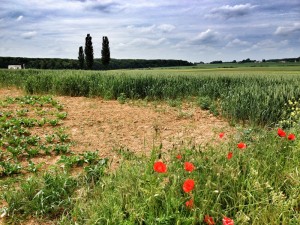
Guillemont – 12th Gloucesters (Bristol’s Own) attacked close to here on 3 September 1916
Individual visits can be accommodated if time permits and locations are close by.
The cost is a competitive £560pp, based on a shared room. For more details please contact me HERE or Mandy Havill, Group Travel Manager on 01934 415 000. I look forward to meeting you on the tour and sharing in Bristol’s fascinating history.
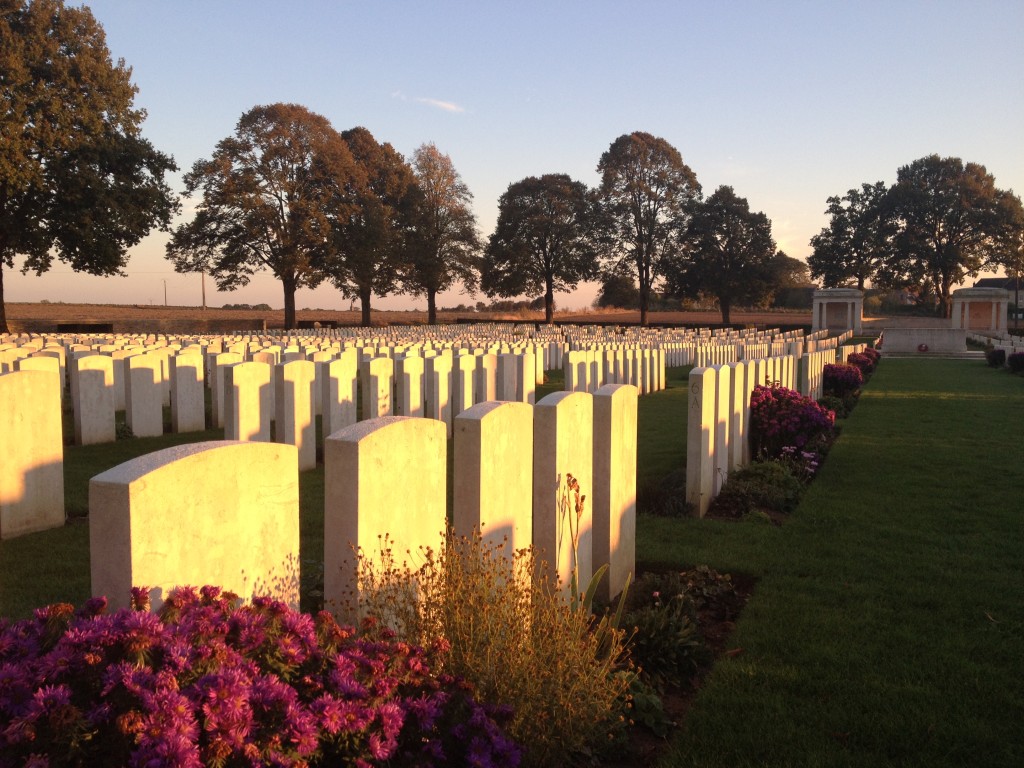
Delville Wood Cemetery, Somme
Lord Kitchener on the £2 Coin. Right or Wrong?
This morning I was invited to speak on BBC Radio Bristol on the subject of the new £2 coin to be issued by the Royal Mint. This coin depicts Lord Kitchener, Secretary of State for War, from his famous ‘Call to Arms’ poster from 1914 – ‘Your Country Needs You’. The Green Party are calling for Kitchener’s image to be removed in preference to one denoting peace. Their argument is that the use of this image glorifies war. See http://www.westernmorningnews.co.uk/Kitchener-2-coin-face-glorifies-war-say-Greens/story-20415940-detail/story.html
Removing Kitchener in preference to a design honouring peace would be a strange decision at this time. It is worth remembering the coin is one of five to be created in the period 2014 – 2018. It is hard to think of a more appropriate design to remember the events of one hundred years ago than this iconic image. Kitchener’s links to our colonial nineteenth century past are undeniable. However, it is not those events the coin is recognising. Neither is it celebrating the man himself, even though he did much to raise an army and organise sufficient munitions to prosecute the war effort. The design is a clear symbol of 1914 and the beginning of the war. I am sure that by 2018 the calls to have a design denoting peace will be strong but that time is not now.
The poster, one of the most iconic of the twentieth century, symbolises the Call to Arms in which men enlisted in the hundreds of thousands into what became the ‘New Army’ or ‘Kitchener’s Army’. That those men went off to various theatres of war to fight is undeniable; inevitably a proportion were killed or wounded in action. However, that is the reality of fighting a modern industrial war. It is a bloody, vicious, all encompassing process which the entire country is part of. As such, large scale casualties are inevitable. Men’s enthusiasm to enlist (for a myriad of reasons and not simply patriotism) and duty ensured the British, for so long reliant on the Royal Navy, could form an army of sufficient size to fight the Germans in continental Europe.
I have read suggestions that an image of Harry Patch be used on the coin as an alternative. Harry was the ‘Last Fighting Tommy’ and won a place in the hearts of many around the world due to his passionate advocacy for peace. I was lucky enough to know him well, looking after him on his pilgrimages back to Flanders. However, whilst he was the last survivor of the trenches, the question remains, was he symbolic of the way that all old soldiers thought? Not at all. As hard as it may be for us to stomach, many of those who went to war enjoyed it, revelling in the experience; the camaraderie, regular food, exercise and the chance to escape their humdrum or dangerous industrial civilian life. These men would never live their life in the same way, never living on the edge again. It would be wrong to say that all soldiers thought like this but, neither did all men who fought share Harry’s views. With millions of service personnel it is inevitable there were many different views. So, would it be a good idea to have Harry on a coin? Only if his views mirror those of every serviceman and woman who did ‘their bit’. Clearly, they do not.
What we are talking about here is a coin – one of five to be created over the next five years. Does it remind me of ‘jingoism’ and the dark days of British colonial expansion? No. It brings to mind 1914 and the mass enlistment of a new army. The irony is that in many ways I am ambivalent to it. It is a coin, that is all. I doubt many could say what image adorns the loose change rattling in their pockets or purses. However, unless a brilliant new design is pushed through that strikes a particular chord then I’ll be happy to go with Lord K and his Call to Arms. If I ever get to see one in my change then my first reaction will probably be to think of that wasted morning I spent talking and writing about it. Which brings me on neatly to my next point….
Like many who spend their life researching and learning about the First World War, either guiding on the battlefields, researching in archives or speaking to schoolchildren I am increasingly disheartened by the events of the first week of 2014 which has seen an ugly war of words between various political parties. I am not alone in finding these arguments, started by Michael Gove in his Daily Mail article, unedifying. Clearly, the centenary offers a perfect opportunity for political parties of every persuasion to have their say on upcoming events, using it for their own political benefit. Making cheap political capital out of this period is opportunistic but, sadly, unsurprising. With the social and economic injustices in this country haven’t we more pressing issues in this country for politicians to deal with?
For many of us with a deep-seated and long-standing interest in the war the focus will remain the men who served, their families who remained at home and that legacy – that is what is important, not political jousting and ‘what if’ history. It is sad to say but after just ten days of the new calendar year I am already looking forward to 2018 and the lessening of media and political interest. At this rate, it cannot come too soon.
The discussion on the Steve Le Fevre BBC Radio Bristol Breakfast Show can be heard via iPlayer for another seven days HERE. The piece starts from 1:49.20 in.
I have been researching certain members of this family after I spotted some graffiti of a Great War soldier, Bombardier Alfred Flux from Hambrook, whilst exploring caves under the church in Bouzincourt on the Somme in May last year. Whilst the caves were covered in graffiti from soldiers from all over the world I was intrigued by this local man and endeavoured to find out more about him.
Full details of this can be found on the newspaper link below as the story was featured in the Armistice Day editions of the Bristol Evening Post, Western Daily Press and Bath Chronicle.
Alfred Flux
832011 Corporal Alfred Ernest Flux, serving with “Y” 61st Trench Mortar Battery, Royal Field Artillery was killed on 21 March 1918, aged 25. He was the son of Alfred William and Emily Flux, of Walton Farm, Hambrook, Bristol and is commemorated on the Pozières Memorial to the Missing.
Alfred had served in 1916 in the Laventie area with involvement in the Battle of Fromelles on 19/20 July 1916 and stayed in this sector until his Division moved south to the Somme in mid-November 1916. The war diary says they were billeted in caves under Bouzincourt Church on 28 November and the graffiti is dated 30 November. The Battery stayed at Bouzincourt until January 1917 and then they went back for rest. February 1917 saw a move to Harbonnieres, south of the River Somme until May 1917. By June 1917 the battery was near Arras and then moved up to the Ypres sector where they were employed as stretcher bearers for the 38th (Welsh) Division in the Canal Bank sector on the first say of the Third Battle of Ypres (Passchendaele). They stayed in the salient until September when they moved back down to the Arras front, holding the dreaded Chemical Works and Greenland Hill sectors for the next two and half months. They then moved down to the Somme area and in January 1918 were ensconced in the Holnon Wood sector west of St Quentin. It was whilst holding these positions against the German Spring Offensive on 21 March 1918 that Alfred Flux was killed.
Since the article being released I have been in further touch with members of the Flux family, notably Judith Pike (who lives in Bristol) and Geoff Hedditch from Echuca, Victoria in Australia. I had done a fair bit of research into the family so knew that Alfred was one of a family of five children but Judith explained that Alfred’s younger brother, Francis Charles (but known as Charlie until his death at the ripe old age of 86 years) had also served as an artilleryman in the Great War. I volunteered to find out as much of his service as I could and was able to produce a detailed report for the family. Luckily, Charlie’s service record had survived and so I could piece together his service with 47 Brigade, RFA and then various Trench Mortar Batteries of the 19th Division. Other than suffering from dysentery in 1915 he appears to have been unwounded and was demobbed in February 1919.
I was both amazed and delighted by the huge amount of detail you have unearthed. Your information has opened up that era in a fascinating way I never expected to happen. I would like to say a big thank you for your diligence in researching my grandfather, and of course, initially finding out so much about his brother Alfred. Thank you for all you have done to bring real colour into our family history, and I want to wish you every success with your work as a researcher of the Great War. Judith Pike, Frenchay, Bristol
I was delighted to receive some post this morning from Geoff Hedditch in Australia. Enclosed in the envelope was a copy of his local newspaper, the Riverine Herald, which included an article about Geoff and his delight at the work I had done. I would like to thank Patrick, Judith and Geoff (all members of the Flux family) and Alan Freke and his fine colleagues at Frenchay Village Museum for their help. It just goes to show what a spark of interest coupled with a bit of determination can achieve – quite amazing that this story could travel all the way to Australia.
Please also remember the Flux boys themselves – Alfred and Charlie – who both answered their country’s call when needed and who, for one, paid the ultimate price.

